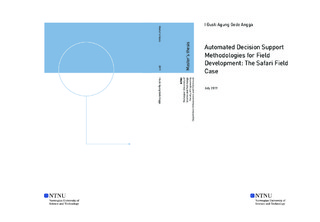| dc.description.abstract | In planning a field development, there are many field design features to be decided upon. The company's development team has a responsibility to determine a configuration of those options which maximizes the value of the company's asset. Automated field development is a cutting-edge methodology to screen and search in an automated manner for the best combination of field design features under a given set of constraints.
This thesis presents an automated field development methodology which is based on mathematical optimization. The methodology is designed for a synthetic (fictitious) case called "Safari". The Safari field is characterized by having multiple reservoir units, where the reservoirs are non-communicating and have unique properties.
In this study, there are two main optimization problems, i.e., maximization of the plateau duration and maximization of the Net Present Value (NPV). The optimization problems include production & injection rates, drilling schedule, and recovery mechanism as the decision variables. Some constraints concerning production, injection, and drilling are also considered in the optimization. Formulations of the optimization problems adapt 2 main ideas, i.e., (1) to use production potential curves as the proxy model of the production system and (2) to use multi-dimensional PWL approximations for representing some non-linear functions. According to the optimization results, a better objective value is obtained when the drilling schedule and recovery mechanism are also defined as the decision variables in addition to fluid rates.
Several evaluations have been performed to make the formulations of the optimization problems and their implementations in AMPL more efficient and more accurate. By adapting the evaluations' results, the optimization process becomes much faster. Furthermore, uncertainties of the optimization results have been quantified through uncertainty analyses. Three uncertain parameters are considered, i.e., in-place, development & operational cost, and oil price. To conduct an uncertainty analysis, two approaches have been studied, i.e., using Latin Hypercube Sampling (LHS) method and using a probability tree. Uncertainty analysis using a probability tree is preferred because it is quicker and produces similar results as the other approach. | |
